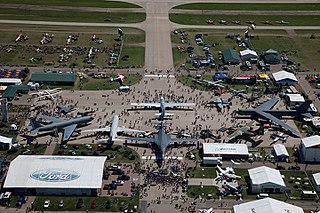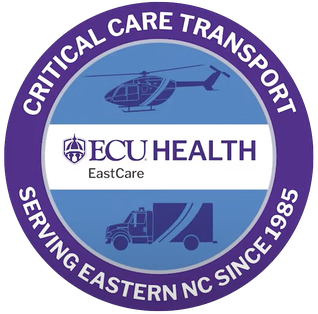
A flight surgeon is a military medical officer practicing in the clinical field of aviation medicine, which is also occasionally known as flight surgery.

EAA AirVenture Oshkosh, or just Oshkosh, is an annual air show and gathering of aviation enthusiasts held each summer at the Wittman Regional Airport and adjacent Pioneer Airport in Oshkosh, Wisconsin, United States. The southern part of the show grounds, as well as "Camp Scholler", are located in the town of Nekimi and a base for seaplanes is located on Lake Winnebago in the town of Black Wolf.

The Experimental Aircraft Association (EAA) is an international organization of aviation enthusiasts based in Oshkosh, Wisconsin. Since its inception, it has grown internationally with over 200,000 members and nearly 1,000 chapters worldwide. It hosts the largest aviation gathering of its kind in the world, EAA AirVenture Oshkosh.

The Aircraft Owners and Pilots Association (AOPA) is a Frederick, Maryland-based American non-profit political organization that advocates for general aviation. AOPA's membership consists mainly of general aviation pilots in the United States. AOPA exists to serve the interests of its members as aircraft owners and pilots and to promote the economy, safety, utility, and popularity of flight in general aviation aircraft.

A fixed-base operator (FBO) is an organization granted the right by an airport to operate at the airport and provide aeronautical services such as fueling, hangaring, tie-down and parking, aircraft rental, aircraft maintenance, flight instruction, and similar services. In common practice, an FBO is the primary provider of support services to general aviation operators at a public-use airport and is on land leased from the airport, or, in rare cases, adjacent property as a "through the fence operation". In many smaller airports serving general aviation in remote or modest communities, the town itself may provide fuel services and operate a basic FBO facility. Most FBOs doing business at airports of high to moderate traffic volume are non-governmental organizations, either privately or publicly held companies.

Aviation medicine, also called flight medicine or aerospace medicine, is a preventive or occupational medicine in which the patients/subjects are pilots, aircrews, or astronauts. The specialty strives to treat or prevent conditions to which aircrews are particularly susceptible, applies medical knowledge to the human factors in aviation and is thus a critical component of aviation safety. A military practitioner of aviation medicine may be called a flight surgeon and a civilian practitioner is an aviation medical examiner. One of the biggest differences between the military and civilian flight doctors is the military flight surgeon's requirement to log flight hours.
The National Aeronautic Association of the United States (NAA) is a non-profit 501(c)(3) organization and a founding member of the Fédération Aéronautique Internationale (FAI). Founded in 1905, it is the oldest national aviation club in the United States and one of the oldest in the world, it serves as the “Aeroclub of the United States” and, by its Mission Statement it is "…dedicated to the advancement of the art, sport and science of aviation in the United States.” The NAA is headquartered at the Ronald Reagan Washington National Airport, in Washington, D.C.

Mission Aviation Fellowship (MAF) is a Christian organization that provides aviation, communications, and learning technology services to more than 1,000 Christian and humanitarian agencies, as well as thousands of isolated missionaries and indigenous villagers in the world's most remote areas. There are three major operational centers – Nampa, Idaho; Ashford, England; and Cairns, Australia. These centres provide operational support to programs in the Americas, Africa and Asia Pacific regions. In 2010, MAF served in more than 55 countries, flying 201,710 passengers with a fleet of some 130 aircraft.

Eddie Andreini Sr. Airfield, officially Half Moon Bay Airport, is a public airport in San Mateo County, six miles (9.7 km) northwest of Half Moon Bay, California, United States. The airport is on the Pacific Coast, south of San Francisco.

The Canadian Owners and Pilots Association (COPA) is a federally registered not-for-profit association that provides information and advocacy services for Canadian pilots who fly for non-commercial purposes.

Aeromedical evacuation (AE) usually refers to the use of military transport aircraft to carry wounded personnel.

Geraldton Airport is an airport located 6 nautical miles east of Geraldton, Western Australia, in Moonyoonooka along the Geraldton – Mount Magnet Road.

Civil Air Patrol (CAP) is a congressionally chartered, federally supported non-profit corporation that serves as the official civilian auxiliary of the United States Air Force (USAF). CAP is a volunteer organization with an aviation-minded membership that includes members from all backgrounds. The program is established as an organization by Title 10 of the United States Code and its purposes defined by Title 36.
Air Evac EMS, Inc., operating as Air Evac Lifeteam and sometimes called simply Air Evac, is an American helicopter emergency medical service (HEMS) or air ambulance provider headquartered in O'Fallon, Missouri. It is the largest subsidiary of Global Medical Response, though still considered an independent provider. It is also the largest membership-supported air ambulance service in the US operating helicopters from 140 bases in 15 states, mostly in the central and southern regions of the country. While primarily a HEMS provider, it also operates 2 fixed-wing aircraft in Missouri and Kentucky.
A compassion flight or public benefit flying mission is an aircraft flight provided in support of humanitarian, charitable, or public benefit purposes. Both the Air Care Alliance and the Federal Aviation Administration in the United States have long referred to these types of flights. Most Compassion Flights are provided by volunteer pilots who are members of public benefit flying organizations, and who donate their time, flying skills, and aircraft for charitable and public service purposes.

ECU Health EastCare is the critical care mobile air and ground transport of ECU Health at ECU Health Medical Center. It serves 31 counties in Eastern North Carolina. It is sponsored by ECU Health Medical Center and The Brody School of Medicine at East Carolina University. ECU Medical Center is the only level 1 trauma center east of Raleigh. EastCare's five full-time air ambulances constitute the largest air medical program in North Carolina and can serve a radius of 230 nautical miles around Greenville without refueling.

The Volunteer Pilots Association (VPA) is an American public benefit flying (PBF) group founded in 1990. The Volunteer Pilots Association provides free non-emergency air transportation to and from medical appointments for patients with a financial need. Headquartered in southwestern Pennsylvania, the VPA is an all-volunteer non-profit organization. All member pilots fly privately owned planes and donate their time and flight expenses.

Angel Flight is the name used by a number of groups whose members provide free air transportation for passengers in need of medical treatment far from home and perform other missions of community service. Such a non-profit organization may be located in the United States, Europe, Australia, or Canada. Transportation is provided by volunteer pilots, often using their own general aviation aircraft. In most of Canada, the Volunteer Pilot Program of Hope Air provides a similar service, along with Angel Flight of Vancouver.

Air medical services are the use of aircraft, including both fixed-wing aircraft and helicopters to provide various kinds of medical care, especially prehospital, emergency and critical care to patients during aeromedical evacuation and rescue operations.

This article incorporates public domain material from websites or documents of the United States Army.